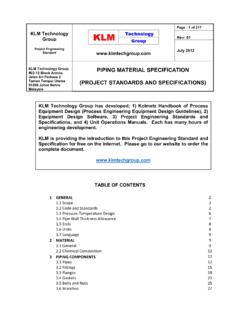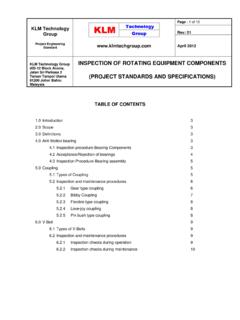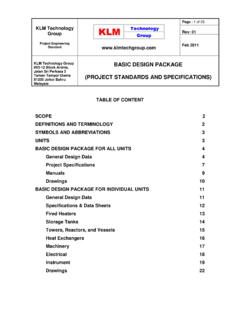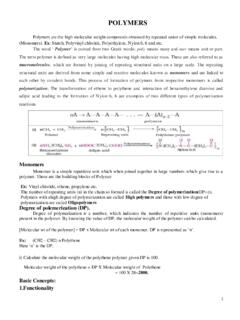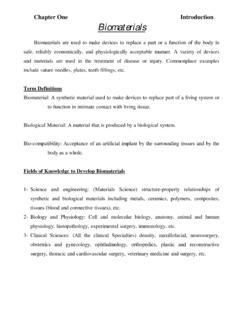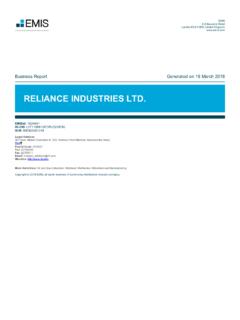Transcription of PROCESS DESIGN OF DRYERS (PROJECT STANDARDS AND ...
1 KLM TechnologyGroupProject :1of48 Rev: 01 April2011 KLM Technology Group#03-12 Block Aronia,Jalan Sri Perkasa 2 Taman Tampoi Utama81200 Johor BahruMalaysiaPROCESS DESIGN OF DRYERS (PROJECT STANDARDS AND SPECIFICATIONS)TABLE OF CONTENTSCOPE2 REFERENCES2 DEFINITIONS AND TERMINOLOGY2 SYMBOLS AND ABBREVIATIONS5 UNITS5 WET SOLID DRYERS5 General5 Drying Characteristics5 Constant-Rate Period7 Critical Moisture Content8 Equilibrium Moisture Content8 Falling-RatePeriod9 Determining of Drying Time10 Psychrometry11 Classification of Industrial Drying11 Selection of Dryer14 Polymer Dryers18 COMPRESSED AIR DRYER31 General31 Rating Parameters and Reference Conditions32 Specification32 ADSORPTION DRYERS35 General35 Solid Desiccant35 Criteria for Solid Desiccant Selection36 DESIGN Basis37 Standard Configuration of Adsorber37 DESIGN Criteria and Calculations41 APPENDIX A47 KLM TechnologyGroupProject Engineering StandardPROCESS DESIGN OF DRYERS (PROJECT STANDARDS ANDSPECIFICATIONS)Page2of48 Rev.
2 01 April2011 SCOPEThis Project STANDARDS and Specificationsis intended to cover minimumrequirements for PROCESS DESIGN of DRYERS used in oil, gas, and petrochemicalprocess , as a common practice, DRYERS are seldom designed by the users, butare brought from companies that are specialized in DESIGN and fabrication ofdrying equipment, the scope covered herein, is for the purpose to establish anddefine general principles on drying concept and mechanism, dryer classificationand selection and to provide acompletedesign information and criteria requiredfor proper selection, DESIGN and operation of solid, liquid and gaseous dryingequipment ( DRYERS ).REFERENCEST hroughout this Standard the following dated and undated STANDARDS /codes arereferred to. These referenced documents shall, to the extent specified herein,form a part of this standard. For dated references, the edition cited applies.
3 Theapplicability of changes in dated references that occur after the cited date shallbe mutually agreed upon by the Company and the Vendor. For undatedreferences, the latest edition ofthe referenced documents (including anysupplements and amendments) (International Standard Organization)7183, 1986"CompressedAirDryers-Specificationsa ndTesting", Section 4, 1st. Ed., 15th March 19861st. Ed., 19815388, 1981"StandardAir Compressors, Safety Rules andCode of Practice",DEFINITIONS AND TERMINOLOGYA diabatic Drying-The drying PROCESS described by a path of content adiabaticcooling temperature on the psychrometric molecules that condense onthe adsorbent surface , waterin the case of Loading-The concentration of adsorbate on adsorbent, usuallyexpressed as kg adsorbate per 100 kg TechnologyGroupProject Engineering StandardPROCESS DESIGN OF DRYERS (PROJECT STANDARDS ANDSPECIFICATIONS)Page3of48 Rev.
4 01 April2011 Adsorbent-A solid material which demonstrates adsorption phenomenon whereby molecules in the fluid phasespontaneously concentrate on a solid surface without undergoing any Selectivity-The preference of a particular adsorbent material forone adsorbate over another based on certain characteristics of the adsorbatesuch as polarity or molecular Flow-Is the flow of liquid through the interstices and over the surfacesof a solid, caused by liquid-solid molecular Period-Is the drying period during which the rate of liquidremoval per unit of drying surface is Moisture Content-Is the moisture content of the material at the end ofthe constant-rate period. The critical moisture content is not a unique property ofthe material but is influenced by its physical shape as well as the conditions ofthe drying Time-The amount of time allocated for one bed in an adsorption systemto complete adsorption to a predetermined outlet specification level and to adsorbent that shows primary selectivity for the removal of adsorbents are not necessarily Fouling-Material adsorbed from the carrier stream may not bedesorbed satisfactorilyon regeneration.
5 Some reaction may also occur on theadsorbent leading to products that are not desorbed. These reaction productsmay inhibit efficient adsorption and obstruct or "foul" capacity of the Basis-A good DESIGN basis requires a sound knowledge of the streamto be processed as well as what the desired outlet specification is and how thesystem will be operated. The DESIGN conditions on which an adsorption system isbased are not necessarily the actual operating conditions, nor the least or moststringent operating Point-Temperature, referred to a specific pressure (degree Celsius), atwhich the water vapor begins to TechnologyGroupProject Engineering StandardPROCESS DESIGN OF DRYERS (PROJECT STANDARDS ANDSPECIFICATIONS)Page4of48 Rev: 01 April2011 Drying-Rate-The amount of water (kg) removed per square meter of dryingarea per hour. Or the volume flow rate of condensed gas at Standard ReferenceAtmosphere Condition of an absolute pressure of kPa ( bar) and atemperature of 15 Loading-The loading of an adsorbate on the given adsorbent,usuallyexpressed in kilogram of adsorbate per hundred kilogram of adsorbentwhen equilibrium is achieved at a given pressure, temperature, andconcentration of the Moisture Content-The amount of moisture, in the solid that is inthermodynamic equilibrium with its vapor in the gas phase, for given temperatureand humidity conditions.
6 The material cannot be dried below its correspondingequilibrium moisture Period-The part of drying time which the drying rate variesin Moisture Content-Is the liquid content that is removable at a giventemperature and humidity. Free moisture may include both bound and unboundmoisture, and is equal to the total average moisture content minus theequilibrium moisture content for the prevailing conditions of Content-The ratio of water and water vapor by mass to the totalvolume (gram per cubic meter).Partial Pressure-Absolute pressure exerted by any component in a mixture(millibar).Relative Humidity (Relative Vapor Pressure)-Ratio of the partial pressure ofwater vapor (millibar) to its saturation pressure (millibar) at the Pressure-Total pressure at which moist air at a certain temperaturecan coexist in equilibrium with a plane surface of pure condensed phase (wateror ice) at the same temperature (millibar).
7 Vapor Concentration (Absolute Humidity)-The ratio of water vapor by massto the total volume (gram per cubic meter).KLM TechnologyGroupProject Engineering StandardPROCESS DESIGN OF DRYERS (PROJECT STANDARDS ANDSPECIFICATIONS)Page5of48 Rev: 01 April2011 Moisture density Moisture pressure of vapor in the gas environment, in(kPa).PPPoly Standard is based on International System of Units (SI) except whereotherwise SOLID DRYERSG eneralIn drying PROCESS the goal of many operations is not only to separate a volatileliquid, but also to produce a dry solid of specific size, shape, porosity, texture,color or flavor. So, well understanding of liquid and vapor mass transfermechanism prior to DESIGN work is strongly drying of wet solids, the following main factors, which essentially are used inprocess DESIGN calculation of DRYERS should be defined in accordance with massand heat transfer principles, PROCESS conditions and drying behavior:-Drying drying characteristics of wet solids is best described by plotting theaverage moisture content of material against elapsed time measured from thebeginning of the drying PROCESS .
8 Fig. 1 represents a typical drying-time TechnologyGroupProject Engineering StandardPROCESS DESIGN OF DRYERS (PROJECT STANDARDS ANDSPECIFICATIONS)Page6of48 Rev: 01 April2011 The experimental estimation of this curve must be made before one canbegin the DESIGN calculations. The influence of the internal and externalvariables of drying on the drying-time curve should be determined in orderthat an optimal DESIGN canbe drying-rate curve, Fig. 2, is drived from the drying-time curve by plottingslopes of the latter curve against the corresponding moisture content. Thedistinctive shape of this plot, shown in Fig. 2, illustrates the constant-rateperiod,terminating at the critical moisture content, followed by the falling-rateperiod. The variables that influence the constant-rate period are the so-calledexternal factors consisting of gas mass velocity, thermodynamic state of thegas, transport properties of the gas, and the state of aggregation of the solidphase changes in gas temperature, humidity, and flow rate will have a pro-found effect on the drying rate during this period.
9 The controlling factors in thefalling-rate period are the transport properties of the solids and the primarydesign variable is characteristic drying behavior in these two period are markedly differentand must be considered in the DESIGN . In the context of economics, it shall becostlier to remove water in the falling-rate period than it is removed in theconstant-rate period, accordingly it is recommended to extend the length ofthe constant-rate period with respect to falling-rate as much 1 Typical Classic Drying-Time CurveKLM TechnologyGroupProject Engineering StandardPROCESS DESIGN OF DRYERS (PROJECT STANDARDS ANDSPECIFICATIONS)Page7of48 Rev: 01 April2011 Fig. 2 Moisture Content, Percent Bone Dry Mass Basis Drying-Rate CurveConstant-Rate Fig. 2, the horizontal segment AB which pertains to the first major dryingperiod is called the constant-rate period. During this period, the solid is so wetthat a continuous film of water exists over the entire drying surface, and thiswater acts as if the solid were not there.
10 If the solid is nonporous, the waterremoved in this period is mainly superficial water on the solid s evaporation from a porous material is subject to the same mechanism asthat from a wet-bulb drying rate in constant-rate period can precisely be calculated fromEquation 1 which is a steady-state relationship between heat and ) (p'K's)t'(tsL'.Ahd dWt Eq. (1)Where:dw/d is drying rate, in (kg/s);htis the sum of all convection, conduction, and radiation componentsof heat transfer, in[kW/(m .K)];Ais surface area for vaporization and heat transfer, in, (m );L sis latent heat of vaporization att's, in (kJ/kg);K ais mass transfer coefficient, in [kg/( .kPa)];tis average source temperature for all components of heattransfer,in kelvin (K);KLM TechnologyGroupProject Engineering StandardPROCESS DESIGN OF DRYERS (PROJECT STANDARDS ANDSPECIFICATIONS)Page8of48 Rev: 01 April2011t sis liquid surface temperature, in kelvin (K);P sis liquid vapor pressure att's, in (kPa);Pis partial pressure ofvapor in the gas environment, in (kPa).



